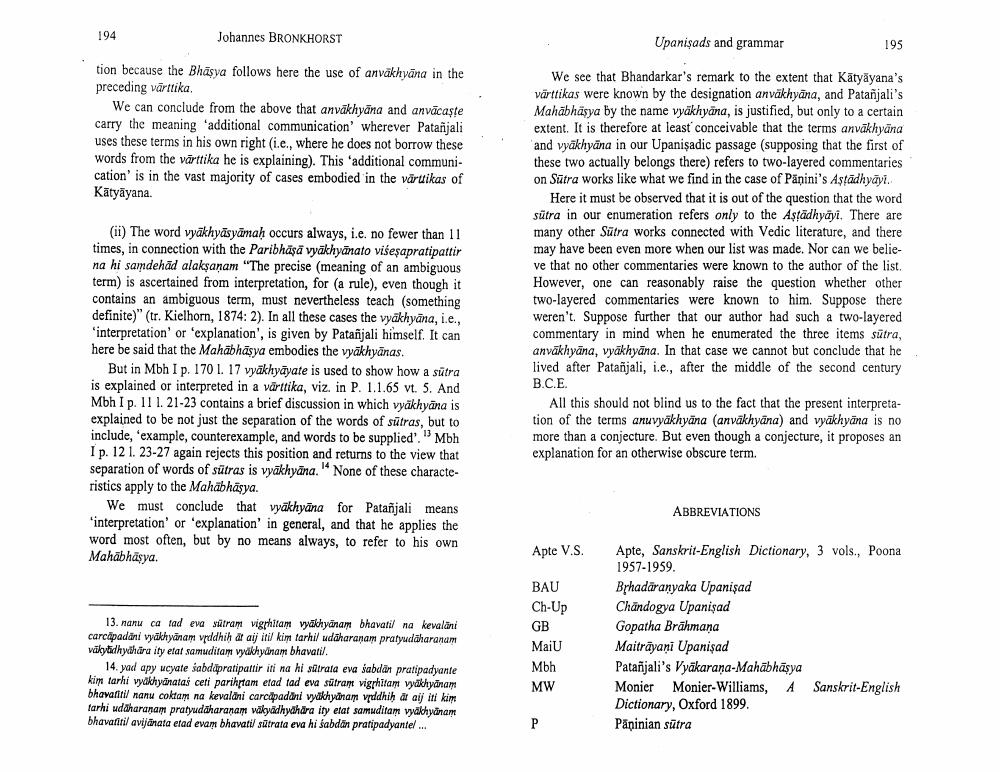________________
194
Johannes BRONKHORST
Upanişads and grammar
195
tion because the Bhāsya follows here the use of anvakhyana in the preceding vārttika
We can conclude from the above that anvākhyāna and anväcaste carry the meaning additional communication wherever Patanjali uses these terms in his own right (i.e., where he does not borrow these words from the värttika he is explaining). This 'additional communication is in the vast majority of cases embodied in the varuikas of Kātyāyana.
We see that Bhandarkar's remark to the extent that Katyayana's värttikas were known by the designation anväkhyāna, and Patañjali's Mahābhäsya by the name vyākhyāna, is justified, but only to a certain extent. It is therefore at least conceivable that the terms anvākhyāna and vyakhyana in our Upanişadic passage (supposing that the first of these two actually belongs there) refers to two-layered commentaries on Sūtra works like what we find in the case of Pāņini's Astādhyayi.
Here it must be observed that it is out of the question that the word sütra in our enumeration refers only to the Astädhyayi. There are many other Sutra works connected with Vedic literature, and there may have been even more when our list was made. Nor can we believe that no other commentaries were known to the author of the list. However, one can reasonably raise the question whether other two-layered commentaries were known to him. Suppose there weren't. Suppose further that our author had such a two-layered commentary in mind when he enumerated the three items sutra, anvākhyāna, vyākhyāna. In that case we cannot but conclude that he lived after Patañjali, i.e., after the middle of the second century B.C.E.
All this should not blind us to the fact that the present interpretation of the terms anuvyākhyāna (anvākhyāna) and vyakhyana is no more than a conjecture. But even though a conjecture, it proposes an explanation for an otherwise obscure term.
(ii) The word vyakhyāsyāmah occurs always, i.e. no fewer than 11 times, in connection with the Paribhāşa vyakhyānato visesapratipattir na hi samdehād alaksanam "The precise (meaning of an ambiguous term) is ascertained from interpretation, for (a rule), even though it contains an ambiguous term, must nevertheless teach (something definite)" (tr. Kielhorn, 1874: 2). In all these cases the vyakhyāna, i.e., 'interpretation' or 'explanation', is given by Patañjali himself. It can here be said that the Mahābhāsya embodies the vyakhyānas.
But in Mbh I p. 170 1. 17 vyakhyāyate is used to show how a sutra is explained or interpreted in a varttika, viz. in P. 1.1.65 vt. 5. And Mbh I p. 111. 21-23 contains a brief discussion in which vyakhyāna is explained to be not just the separation of the words of sütras, but to include, example, counterexample, and words to be supplied'. "Mbh I p. 12 1. 23-27 again rejects this position and returns to the view that separation of words of sütras is vyakhyāna." None of these characteristics apply to the Mahābhāsya.
We must conclude that vyākhyāna for Patanjali means 'interpretation' or 'explanation' in general, and that he applies the word most often, but by no means always, to refer to his own Mahābhāsya.
C.E.
ABBREVIATIONS
Apte V.S.
13. nanu ca tad eva sūtram vigrhitam vākhyānam bhavati na kevalani carcapadani vyakhyānam vrddhih ar aijiti kim tarhil udāharanam pratyudaharanam vākytidhychära ity etat samuditam vyakhyanam bhavati.
14. yad apy weyate sabdápratipattir iti na hi satrata eva Sabdan pratipadyante kim tarhi vyakhyanatas ceti parihtam etad tad eva sūtramt vigrhitam vyakhyanam bhavatitil nanu coktam na kevaldni carcapadani vyakhyanam wrddhih ar aij iti kim tarhi udaharanam pratyudäharanam vākyadhyahara ity etat samuditam vyakhyānam bhavanti avijanata etad enam bhavati sūtrata eva hi sabdan pratipadyantel ...
BAU Ch-Up GB MaiU Mbh MW
Apte, Sanskrit-English Dictionary, 3 vols., Poona 1957-1959. Byhadāranyaka Upanişad Chandogya Upanişad Gopatha Brāhmana Maitrāyaṇi Upanişad Patañjali's Vyākarana-Mahābhāsya Monier Monier-Williams, A Sanskrit-English Dictionary, Oxford 1899. Pāņinian sūtra




